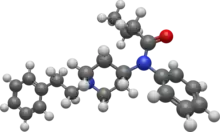 | |
 | |
| Clinical data | |
|---|---|
| ATC code |
|
| Legal status | |
| Legal status |
|
| Identifiers | |
| |
| CAS Number | |
| PubChem CID | |
| ChemSpider | |
| UNII | |
| KEGG | |
| CompTox Dashboard (EPA) | |
| Chemical and physical data | |
| Formula | C23H30N2O |
| Molar mass | 350.506 g·mol−1 |
| 3D model (JSmol) | |
| |
| |
| (verify) | |
Butyrfentanyl or butyrylfentanyl is a potent short-acting synthetic opioid analgesic drug. It is an analog of fentanyl with around one quarter of its potency. One of the first mentions of this drug can be found in document written by The College on Problem of Drug Dependence, where it is mentioned as N-butyramide fentanyl analog.[1] This document also states that the article describing its clinical effects (analgesic studies, μ-, δ-, κ-opioid receptor binding, and in vitro measures of drug efficacy, antinociceptive, and narcotic properties) was published in 1987. It is an agonist for the μ-opioid receptors.[2]
Butyrfentanyl has no current legitimate clinical applications; however, it is being sold as a designer drug.[3]
Side effects of fentanyl analogs are similar to those of fentanyl itself, which include itching, nausea, and potentially serious respiratory depression which can be life-threatening. Fentanyl analogs have killed hundreds of people throughout Europe and the former Soviet republics since the most recent resurgence in use began in Estonia in the early 2000s, and novel derivatives continue to appear.[4]
Pharmacokinetics
Butyrfentanyl binds to the opioid receptor. During the studies of in vitro inhibition of specific [3H] fentanyl binding to the opioid receptor, the order of analogues was: (±)-cis-3-methylfentanyl > fentanyl = alpha-methylfentanyl > butyrylfentanyl > benzylfentanyl.[2] The studies in inhibition studies on binding affinity achieved the same order of analogues. It means that butyrfentantyl is a less potent opioid-agonist than fentanyl. On the other side, during in vitro studies of cross-reactivity with the fentanyl antibody between fentanyl and the fentanyl analogs examined, revealed order: fentanyl = butyrylfentanyl > (±)-cis-3-methylfentanyl > benzylfentanyl > alpha-methylfentanyl.[2] High cross-reactivity may be the effect of the shape of the molecule — the shape of butyrfentanyl is closest to the original fentanyl molecule, which makes it easy to bind by fentanyl antibodies.
The opioid receptor affinity of fentanyl and its analogs was determined from their inhibitory potency in a binding assay with [3H] fentanyl as the radioligand. The Ki value for butyrfentanyl was 32 ± 4.1 nM. Comparing to fentanyl's Ki (1.06 ± 0.15 nM), butyrfentanyl's ability to displace [3H] fentanyl is low and it requires high concentrations of the drug.[2]
Studies on urinary excretion revealed that almost all of the injected butyrfentanyl was excreted or metabolized within the first 3 hours after injection, and only very low concentrations were still detectable after 3 hours.[2] Urinary concentrations of butyrylfentanyl from animals injected with 15 μg/kg and 45 μg/kg i.v. were measured by two techniques: radioreceptorassay and gas chromatography/mass spectrometry (GC/MS).
Legal status
There was a proposal being discussed by the UN Commission on Narcotic Drugs (CND) to include butyrfentanyl in Schedule 1 of the 1961 Single Convention on Narcotic Drugs which was passed 16 March 2017.[5]
United Kingdom
Butyrfentanyl is illegal in the United Kingdom as it is a modification of fentanyl "by replacement of the N-propionyl group by another acyl group".
United States
As of May 2016, butyrfentanyl is a Schedule I controlled substance in the United States.[6]
China
As of October 2015, butyrfentanyl is a controlled substance in China.[7]
Switzerland
Butyrfentanyl is illegal in Switzerland as of December 2015.[8]
See also
References
- ↑ "The College on Problem of Drug Dependence" (PDF). Archived from the original (PDF) on 19 December 2013., Foreword to the Drug Evaluation Committee (DEC) Analgesic, Stimulant, and Depressant Drug Indices
- 1 2 3 4 5 Alburges ME (June 1988). Utilization of a radioreceptor assay for the analysis of fentanyl analogs in urine (PDF) (Ph.D. thesis). The University of Utah. Archived from the original (PDF) on 19 December 2013.
- ↑ McIntyre IM, Trochta A, Gary RD, Wright J, Mena O (March 2016). "An Acute Butyr-Fentanyl Fatality: A Case Report with Postmortem Concentrations". Journal of Analytical Toxicology. 40 (2): 162–166. doi:10.1093/jat/bkv138. PMID 26683128.
- ↑ Mounteney J, Giraudon I, Denissov G, Griffiths P (July 2015). "Fentanyls: Are we missing the signs? Highly potent and on the rise in Europe". The International Journal on Drug Policy. 26 (7): 626–631. doi:10.1016/j.drugpo.2015.04.003. PMID 25976511.
- ↑ "Inclusion of butyrfentanyl in Schedule I of the Single Convention on Narcotic Drugs of 1961 as amended by the 1972 Protocol" (PDF).
- ↑ "Schedules of Controlled Substances: Temporary Placement of Butyryl Fentanyl and Beta-Hydroxythiofentanyl into Schedule I" (PDF). Drug Enforcement Administration. 12 May 2016.
- ↑ "关于印发《非药用类麻醉药品和精神药品列管办法》的通知" [Notice on Issuing the Measures for the Listing and Control of Non-Medicinal Narcotic Drugs and Psychotropic Substances] (in Chinese). China Food and Drug Administration. 27 September 2015. Archived from the original on 1 October 2015. Retrieved 1 October 2015.
- ↑ "Verordnung des EDI über die Verzeichnisse der Betäubungsmittel, psychotropen Stoffe, Vorläuferstoffe und Hilfschemikalien" [EDI regulation on the lists of narcotics, psychotropic substances, precursor substances and auxiliary chemicals] (in German). Der Bundesrat.
Further reading
- Higashikawa Y, Suzuki S (June 2008). "Studies on 1-(2-phenethyl)-4-(N-propionylanilino)piperidine (fentanyl) and its related compounds. VI. Structure-analgesic activity relationship for fentanyl, methyl-substituted fentanyls and other analogues". Forensic Toxicology. 26 (1): 1–5. doi:10.1007/s11419-007-0039-1. S2CID 22092512.
- Alburges ME, Hanson GR, Gibb JW, Sakashita CO, Rollins DE (1992). "Fentanyl receptor assay. II. Utilization of a radioreceptor assay for the analysis of fentanyl analogs in urine". Journal of Analytical Toxicology. 16 (1): 36–41. doi:10.1093/jat/16.1.36. PMID 1322477.
- Woods J, Medzihradsky F, Smith C, Winger G, Gmerek D (1988). "Evaluation of new compounds for opioid activity: 1987 annual report". NIDA Research Monograph. 81: 543–590. PMID 3136388.
- Aceto M, Bowman E, Harris L, May E (1988). "Dependence studies of new compounds in the rhesus monkey, rat, and mouse, 1987". NIDA Research Monograph. 81: 485–542. PMID 3136386.
- Brine GA, Boldt KG, Huang PT, Sawyer DK, Carroll FI (2009). "Carbon-13 nuclear magnetic resonance spectra of fentanyl analogs". Journal of Heterocyclic Chemistry. 26 (3): 677–686. doi:10.1002/jhet.5570260329.